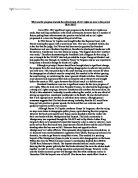Assess the value of these three sources to a historian studying the issue of civil rights under the Eisenhower presidency. Speeches by Senator Eastland, MLK and Governor Faubus.
01 With reference to these sources and your understanding of the historical context, assess the value of these three sources of an historian studying the issue of civil rights under the Eisenhower presidency.
(30 marks)
Source A is delivered by Dixiecrat, deep south Senator Eastland to the Senate floor after the decision of the SCOTUS in Brown v. Board. The tone of the source is persuasive to convince not only his other colleagues but the public at-large who would review these records that segregation was “desired and supported by a vast majority of both races'' even though this is easily disproved with the celebrations following the release of the opinion in Brown and the continued litigation in the Courts led by the NAACP. The Source clearly shows to a historian that the Senator presents a representative view of whites on segregation in the South, making the source useful to an extent. Eastland also states that both races live in “harmonious conditions” even though this is evidently untrue and emphasised with the lynching of Emett Till and his murdered being found not guilty by an all-white jury.
The Source also reflects the views of the more radical Dixiecrats in Congress that opposed civil rights and shows the foundations of which the Southern Manifesto of 1956 was built upon. Eastland emphasises the law of the land, the “Constitution” but then decides to eviscerate the Supreme Court for enforcing and interpreting such, showing that his allegiance is not to the Constitution as interpreted by the Courts but the Constitution as fits his segregationist narrative, therefore impacting the reliability of the source. Eastland also refers to states rights, a common held belief in the South, and opposes the Supreme Court’s intervention even though Art. III in the Constitution makes them the supreme authority of the land. While the Source is helpful in showing the sentiment of the South and the eventual creation of the Southern Manifesto it is also less helpful because it shows Eastland is willing to state anything to provide to maintain the illusion that segregation is a positive, including lie. Overall, the Source has a limited usefulness to a historian.








